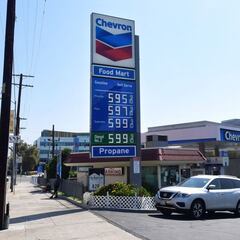Illinois Gas Tax: how much is going up? how has its price changed?
Gas prices in Illinois are sky-rocketing, but is the 2019 gas tax increase driving the price surge. Our team took a look at the trend in prices.


Of the 12.6 million people that live in Illinois, 9.5 million live in the Chicago Metro Area. The average weekly gas price in Chicago hit $3.42 last week. This is the highest price recorded by the US Energy Information Administration (EIA) for Chicago since 2014.
In 2018, the average cost of one gallon of gasoline was $2.90, and in 2019, the average fell to $2.87. In 2020, the price of gas fell across the country, and in the Chicago area, the price was brought down to $2.43 -- nearly a full dollar lower than the prices recorded in the last week.
One of the drivers behind this increase in price is a bill passed in 2019, which doubled the value of the state's gas tax. Rather than those in the state paying nineteen cents per gallon, the value was increased to thirty-six cents.
Additionally, the law called for a yearly increase on 1 July each year, meaning that today, the price will be increased by a fraction of a penny per gallon. However, this small increase adds up with some estimating that “the average driver in Illinois will be paying $105.67 more per year than they did before the gas tax doubled.”
Get ready to pay more at pump in Illinois. IL gas tax rising again today. It’s going up a half cent per gallon- 38.7 cents per gallon to 39.2 cents per gallon. This is 3rd time in 3 yrs that IL gas tax has gone up. On 7/1/20 it went up .7 cents per gallon. In 2019, it doubled.
— Chris Regnier (@chrisregniertv) July 1, 2021
After the 1 July increase in 2020, Illinois reportedly had the third-highest gas prices in the country. But, because of the record decline in demand and subsequent drop in prices, the gas tax impact was not really felt by consumers.
What else driving the increase in fuel prices?
The price shocks being felt in Illinois are being reflected around the country. The EIA reported that the “substantial decrease in demand” fueled by the pandemic “made it more challenging for some refineries which convert crude oil into gasoline to operate.” On 1 January 2021, the number of refineries operating in the US was one hundred and twenty-five, ten lower than 2020.
These closures led to a decrease in the amount of crude oil able to be refined. In 2020, the level of crude oil sent to refineries dropped to an average of 14.2 million gallons a day, the lowest level in over a decade.
Related stories
Today, the circulation of crude oil has not reached pre-pandemic levels, showing that issues in the supply chain could keep the price of gasoline higher. In addition to the closures, which will limit the amount of gasoline able to be refined, there may not be enough truck drivers to transport either crude oil or gasoline once refined. The lack of transporters can create bottlenecks in the supply chain wherein the supply exists but can not make it to the consumer fast enough to bring down the price.
Gas prices are surging this holiday weekend due to a labor shortage with truck drivers. CNN's @AlisonKosik reports. https://t.co/MFgcWDgS2Y pic.twitter.com/Ow5sJlZGjT
— CNN (@CNN) July 2, 2021
In 2020, as lockdowns limited the movement, demand for gasoline fell to some of the lowest levels ever recorded. With production unable to slow to meet this demand, prices fell rapidly. However, now as more states, including Illinois, increasing demand cannot be met with the supply needed to bring prices down.
With an increase in demand, an increase in price usually follows. With demand increasing and many eager to use their car, businesses can offer a higher price because they know the consumer will pay. As the economy and consumer choice return to their pre-pandemic levels, prices should fall, but it may take some time before gas buyers see that reflected in their receipts at the pump.

